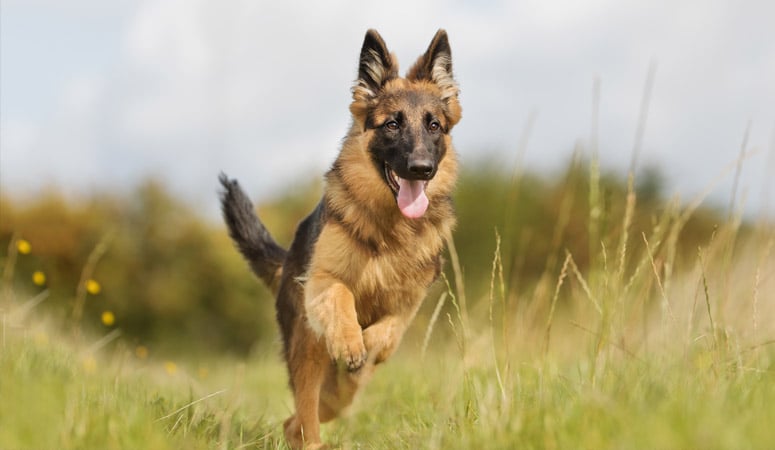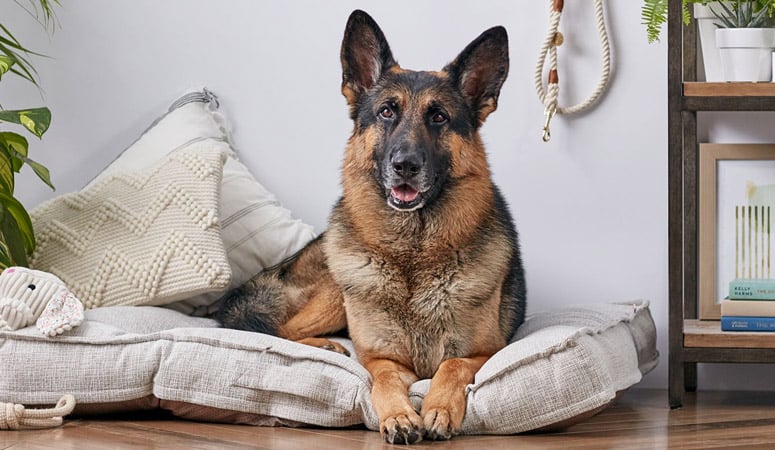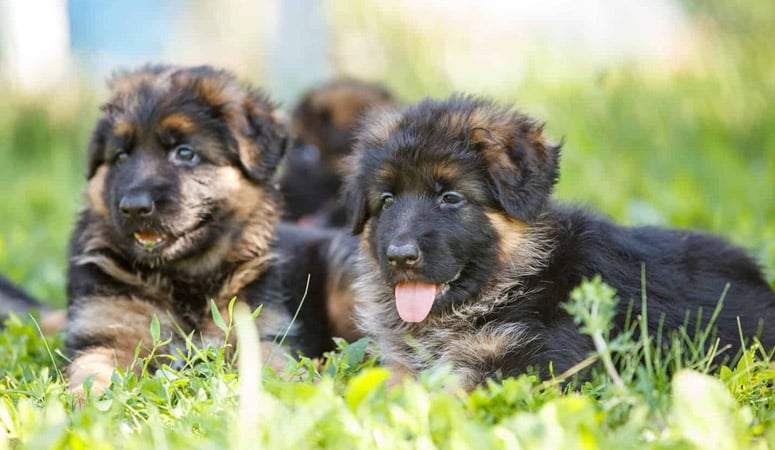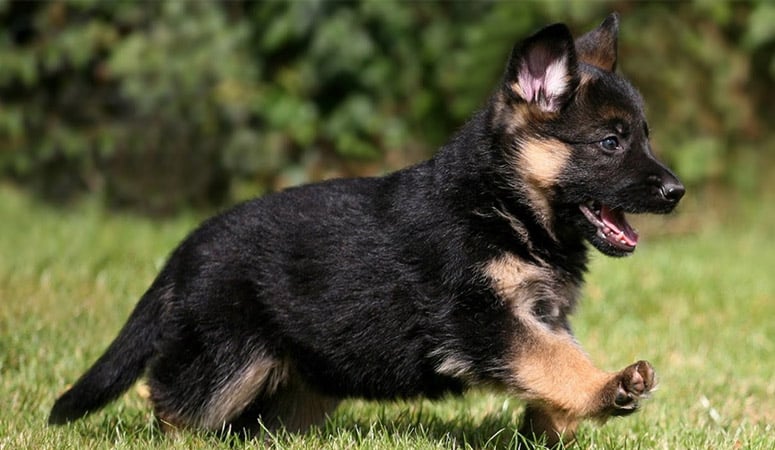German Shepherd Dog
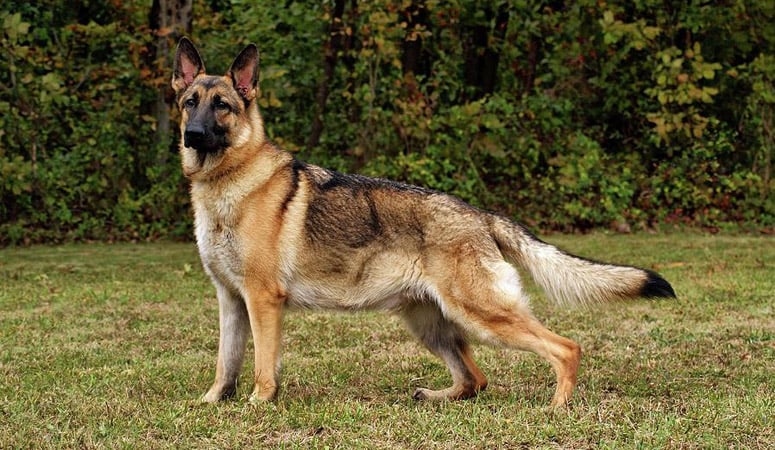
As the second most popular breed in the United States in 2016, the German shepherd dogs are loyal, strong-nerved, muscular, confident, courageous, fearless, and highly intelligent. Since they have strong obedience, the German shepherd dogs could always follow the training instructions and perform well in searching drugs, tracking criminals, mountain rescuing, explosives detection, and disability assistance.
| Other Names | Alsatian, BerGer Allemand, Deutscher Schaferhund, German Shepherd Dog, Pastor Aleman |
| Color | Tan/Black or Red/Black |
| Height | Males: 23-26 inches. Females: 21-24 inches. |
| Weight | Males: 66-88 pounds. Females: 48-71 pounds. |
| Life Span | 7-10 years |
| Personality | Strong-nerved, Fearless, Self-assured |
| Exercise | Regular Exercise |
| Origin |
| Popularity | #2 |
| Groom Needs | Weekly Brushing, Regularly Shedding |
| Kids Friendly | Yes |
| Dog Friendly | Yes with supervision |
| Watch Dog | Yes |
| Family Dog | Yes |
| Litter Size | 4–9 |
German Shepherd Dog Pictures
German Shepherd Dog Video
Introduction
The magnificent German Shepherd dog is a large dog, weighing about 30-40 kilograms for the male, a bit smaller for the female. Its height is around 63 centimeters with many standard colors; in fact, 11 colors are recognized by the American Kennel Club. He has a noble character, super intelligence, is confident, courageous, and loyal. Although the dog was bred originally from Germany, it was bred outside of Germany too. But after WW2, there was quite a bit of anti-German sentiment going around and it was thought the word ‘German’ in the name of the dog would dampen its popularity – so it was renamed ‘Alsatian’ which comes from the French-German border city of Alsace. Eventually, around 1977, the name was reversed again and the breed became known as German Shepherd. In 2010 the name ‘Alsatian’ was done away with. Over the years, the German Shepherd has been bred for its amazing intelligence, ranking just behind the Border collie and poodle breeds. They have other names too: GSD, Berger Allemand, Deutscher Schäferhund, and Schäferhund. The German Shepherd Club was formed in 1913, under the parent club, the AKC, with our beautiful German Shepherd dog coming in second in the popularity stakes.
Living with German Shepherd Dog
The German Shepherd Dog has double coats: the outer coat of harsh hairs and the undercoat of softer hairs. Regular grooming could improve the dog’s blood circulation and stop the dog’s coat from being tangled. It is recommended to groom your German Shepherd every few days. Firstly, prepare your grooming kit and bath your dog with pet shampoo to get rid of the doggy smell. Keep in mind that the German Shepherd only needs an occasional bath. Skip the first step if you have showered your dog recently. Secondly, dry your dog with a dog hairdryer. Since dogs are unable to blow air out of their mouths, therefore, avoid blowing air into the dog’s face or ears while drying. Thirdly, gently brush your dog with slicker brushes from his head to tail to remove loose undercoat, debris, and stray hairs. Moreover, you could also check your dog’s skin condition and trim his nails while grooming.
According to the dog breed information published on the Kennel Club, German Shepherd needs no less than 2 hours of exercise per day for his physical and mental health. Since German Shepherd Dogs are very active and athletic, insufficient physical activity could lead to overweight, stress, and frustration. There are some suggestions that you could consider when you build activities into your German Shepherd exercise routine:
- Visiting the Dog Park
- Participating in an Obedience Class/School
- Tricks Training
- Walking / Running / Hiking
- Fetch
- Rollerblading
- Cycling / Bikejoring
- Swimming
However, the exact frequency and duration for exercise could vary based on the dog’s age, size, and health status. You could consult your veterinarian for more information. Besides physical training, you could also stimulate your dog’s brain by mental exercises including but not limited to learning new tricks, playing with puzzle toys, going on scavenger hunts, retrieving specific items, and playing the shell game.
When feeding your dog, you must take dog size, age, activity level, health status into considerations. For instance, as one of the important nutrients and essential minerals, puppies need more calcium to support their teeth growth and bone health than adult German Shepherds. You could refer to the chart on dog food bags but don’t be so strict with the food amounts. Always observe your dog’s bathroom habits, weight, or energy level and adjust the meal if necessary.
Generally, try to avoid feeding your dog processed foods, fatty foods, and table scraps. It is not recommended to add vitamin and mineral supplements to your dog’s diet neither as most of the dog kibble has already offered sufficient and balanced nutrition.
Additionally, having irregular meals could affect the dog’s appetite and disrupt the digestive system. Therefore, it is highly recommended to feed your German Shepherd at set mealtimes and with a set amount.
Hip dysplasia is the number one health problem that affects German Shepherds’ well-being. Hip dysplasia, also known as genetic hip deformity, is a skeletal condition that the head of the femur (thighbone) and hip socket grow abnormally, which causes lameness, pain, and arthritis of the joints. Hip dysplasia could be diagnosed by X-rays and must be treated with surgeries. German Shepherds owners should educate themselves about the symptoms and buy pet insurance for their dogs to avoid extensive veterinarian bills.
Besides hip dysplasia, German Shepherds are at high risks of suffering from other health problems such as elbow dysplasia, epilepsy, cataracts, hemophilia, bloat or gastric dilatation-volvulus (GDV), degenerative disc disease, thyroid issues, diabetes, urinary tract infections, bladder stones, pancreatitis, allergies, etc.
Total Annual Cost: $3565
Cost is estimated for the first year and may vary depending on many factors, such as dog food, health care, leash, collar, licensing, possible fencing, crates, training and obedience classes, dog-walking, grooming, treats, toys, flea, tick, and heart-worm meds, microchips, etc.
It is better to train your German Shepherd from an early age. Proper training with constant practice could encourage good behaviors and extinguish negative behaviors. Let your puppy adapt to the new environment and get familiar with your family for the first 2 months. And from 8 to 16 weeks, you could start with some easy trainings such as socialization, crate training, and house training. From 3 to 9 months, you could begin obedience training, recall training, and impulse control training. This timeline could be a guide to ensure that you are training your German Shepherd in the right way during the critical stages of the puppy’s life.
History
During the 1850s, in Europe, there were attempts to standardize this breed in Germany. To do this, the Phylax Society was formed, but because of conflicts, it was disbanded 3 years later. Nevertheless, the Phylax Society did inspire people to pursue standardizing dog breeds independently. One man, Max van Stgephanitz, a member of Phylax, believed that dogs should be bred for working purposes.
In 1899 while attending a dog show, he met a dog, Hektor Linksrhein. Von Stephanitz believed this dog to be the ultimate in looks for a working dog – also he adored the dog’s loyalty, beauty, and intelligence. He bought the dog on the spot, changing his name to Horand von Grafrath.
He then founded the Society for the German Shepherd Dog, and Horand was the first German Shepherd Dog to be added to the society’s breed register. He fathered many pups, and from all the ensuing pups, a genetic link was drawn.
Von Stephanitz has always been credited with being the creator of the German Shepherd dog. Adolf Hitler had a German Shepherd called “Prinz” whom he became separated from at one stage, but the dog escaped and returned to him. Hitler adored the dog’s amazing loyalty and obedience and grew to love the breed. Makes sense, doesn’t it?
Helpful Information
Breed Club: GERMAN SHEPHERD DOG CLUB OF AMERICA
Breed Club Link: https://www.gsdca.org/
Breed Club Rescue: GERMAN SHEPHERD DOG CLUB OF AMERICA
Breed Club Rescue Link: https://www.gsdca.org/

